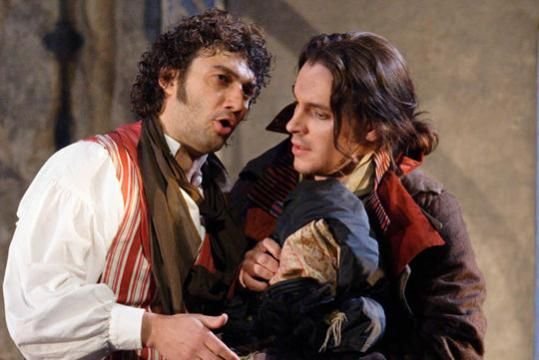|
|
|
|
|
|
|
|
| classicalsource.com |
| Michael Darvell |
Puccini: Tosca, London, ROH, 12 May 2008
|
The Royal Opera – Tosca
|
|
|
 It is taking some time to confine the Royal
Opera’s previous production of “Tosca” to the backburner of one’s memory.
Franco Zeffirelli’s production from 1964 lasted all of forty years. It was
re-staged in 1991 by John Cox but was essentially the same production so
that, whoever was singing the principal roles, there was always the
continuity of the production itself that kept it an abiding part of one’s
recollection of the opera-going experience. You used to be able to tell an
opera merely from looking at the set and costume designs alone (in fact BBC
Television’s “Face the Music” quiz had a round devoted to doing just that).
Contemporary productions tend not to be built to last or indeed to be
admired. Alienation is an effect often achieved in the opera world at a time
when directors and designers are given free rein, regardless of what the
conductor and singers have in mind. It is taking some time to confine the Royal
Opera’s previous production of “Tosca” to the backburner of one’s memory.
Franco Zeffirelli’s production from 1964 lasted all of forty years. It was
re-staged in 1991 by John Cox but was essentially the same production so
that, whoever was singing the principal roles, there was always the
continuity of the production itself that kept it an abiding part of one’s
recollection of the opera-going experience. You used to be able to tell an
opera merely from looking at the set and costume designs alone (in fact BBC
Television’s “Face the Music” quiz had a round devoted to doing just that).
Contemporary productions tend not to be built to last or indeed to be
admired. Alienation is an effect often achieved in the opera world at a time
when directors and designers are given free rein, regardless of what the
conductor and singers have in mind.
Jonathan Kent’s production of “Tosca” at Covent Garden, first seen in 2006,
is far from outrageous and indeed is fairly traditional, but Renzo
Mongiardino’s designs for the 1964 production had a solidity that Paul
Brown’s current settings do not match. The Act One scene in the church of
San’Angelo della Valle seems cramped and cluttered. The middle act,
Scarpia’s apartment at the Palazzo Farnese, is dark in the extreme, no doubt
befitting the events taking place – torture of a prisoner, a would-be
seduction and a murder. The final act on the ramparts of Castel Sant’Angelo
looks more modern, a simple, space-age view more akin to Flash Gordon. No
doubt we will eventually become accustomed to the new look.
This is the production’s second revival (directed by Stephen Barlow) in
which the principal singers are definitely cast from strength. Antonio
Pappano conducts with great feeling for Puccini’s exquisite music, wringing
every last drop of emotion from the score, which the Royal Opera Orchestra
plays with skill and passion.
As Tosca Italian soprano Micaela Carosi is making her ROH debut and she
manages the change of moods from a lover’s jealousy to raging hatred with
requisite assurance. In ‘Vissi d’arte’ (I have lived for art), her sudden
stillness amid the tragic turn of events is beautifully conveyed. As
Cavaradossi Jonas Kaufmann is already an ROH favourite and his role of
artist turned tragic hero is well acted and exceedingly well sung. His
moving performance is exemplified in the aria ‘E lucevan le stelle’ (The
stars were shining). Paolo Gavanelli, again no stranger to Covent
Garden, is perhaps less creepy and conniving than some in the role of
Scarpia but he gives a big, bullish performance, all bluster and shouting (I
note he has Verdi’s “Falstaff” in his repertoire) and at the same time
conveying very impressively the sadomasochistic nature of the perverted
Chief of Police.
All three singers were applauded to the rafters on this first night.
Fresh from their success in “Simon Boccanegra”, the Royal Opera Chorus again
produced a marvellous sound, bringing a true tingle-factor to the ‘Te Deum’
in the Act One finale. |
|
|
|
|
|
|
|
|
|
|
|
|
|
|
|
|
|
|